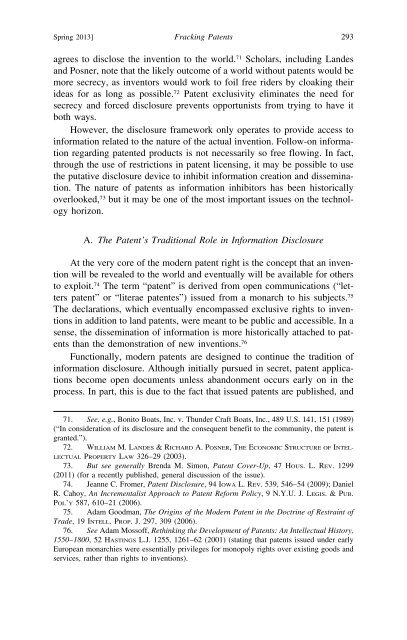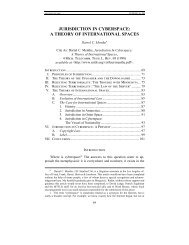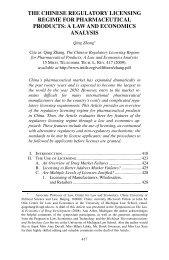Fracking Patents - Michigan Telecommunications and Technology ...
Fracking Patents - Michigan Telecommunications and Technology ...
Fracking Patents - Michigan Telecommunications and Technology ...
- No tags were found...
Create successful ePaper yourself
Turn your PDF publications into a flip-book with our unique Google optimized e-Paper software.
Spring 2013] <strong>Fracking</strong> <strong>Patents</strong> 293agrees to disclose the invention to the world. 71 Scholars, including L<strong>and</strong>es<strong>and</strong> Posner, note that the likely outcome of a world without patents would bemore secrecy, as inventors would work to foil free riders by cloaking theirideas for as long as possible. 72 Patent exclusivity eliminates the need forsecrecy <strong>and</strong> forced disclosure prevents opportunists from trying to have itboth ways.However, the disclosure framework only operates to provide access toinformation related to the nature of the actual invention. Follow-on informationregarding patented products is not necessarily so free flowing. In fact,through the use of restrictions in patent licensing, it may be possible to usethe putative disclosure device to inhibit information creation <strong>and</strong> dissemination.The nature of patents as information inhibitors has been historicallyoverlooked, 73 but it may be one of the most important issues on the technologyhorizon.A. The Patent’s Traditional Role in Information DisclosureAt the very core of the modern patent right is the concept that an inventionwill be revealed to the world <strong>and</strong> eventually will be available for othersto exploit. 74 The term “patent” is derived from open communications (“letterspatent” or “literae patentes”) issued from a monarch to his subjects. 75The declarations, which eventually encompassed exclusive rights to inventionsin addition to l<strong>and</strong> patents, were meant to be public <strong>and</strong> accessible. In asense, the dissemination of information is more historically attached to patentsthan the demonstration of new inventions. 76Functionally, modern patents are designed to continue the tradition ofinformation disclosure. Although initially pursued in secret, patent applicationsbecome open documents unless ab<strong>and</strong>onment occurs early on in theprocess. In part, this is due to the fact that issued patents are published, <strong>and</strong>71. See, e.g., Bonito Boats, Inc. v. Thunder Craft Boats, Inc., 489 U.S. 141, 151 (1989)(“In consideration of its disclosure <strong>and</strong> the consequent benefit to the community, the patent isgranted.”).72. WILLIAM M. LANDES & RICHARD A. POSNER, THE ECONOMIC STRUCTURE OF INTEL-LECTUAL PROPERTY LAW 326–29 (2003).73. But see generally Brenda M. Simon, Patent Cover-Up, 47 HOUS. L. REV. 1299(2011) (for a recently published, general discussion of the issue).74. Jeanne C. Fromer, Patent Disclosure, 94 IOWA L. REV. 539, 546–54 (2009); DanielR. Cahoy, An Incrementalist Approach to Patent Reform Policy, 9 N.Y.U. J. LEGIS. & PUB.POL’Y 587, 610–21 (2006).75. Adam Goodman, The Origins of the Modern Patent in the Doctrine of Restraint ofTrade, 19 INTELL. PROP. J. 297, 309 (2006).76. See Adam Mossoff, Rethinking the Development of <strong>Patents</strong>: An Intellectual History,1550–1800, 52 HASTINGS L.J. 1255, 1261–62 (2001) (stating that patents issued under earlyEuropean monarchies were essentially privileges for monopoly rights over existing goods <strong>and</strong>services, rather than rights to inventions).






